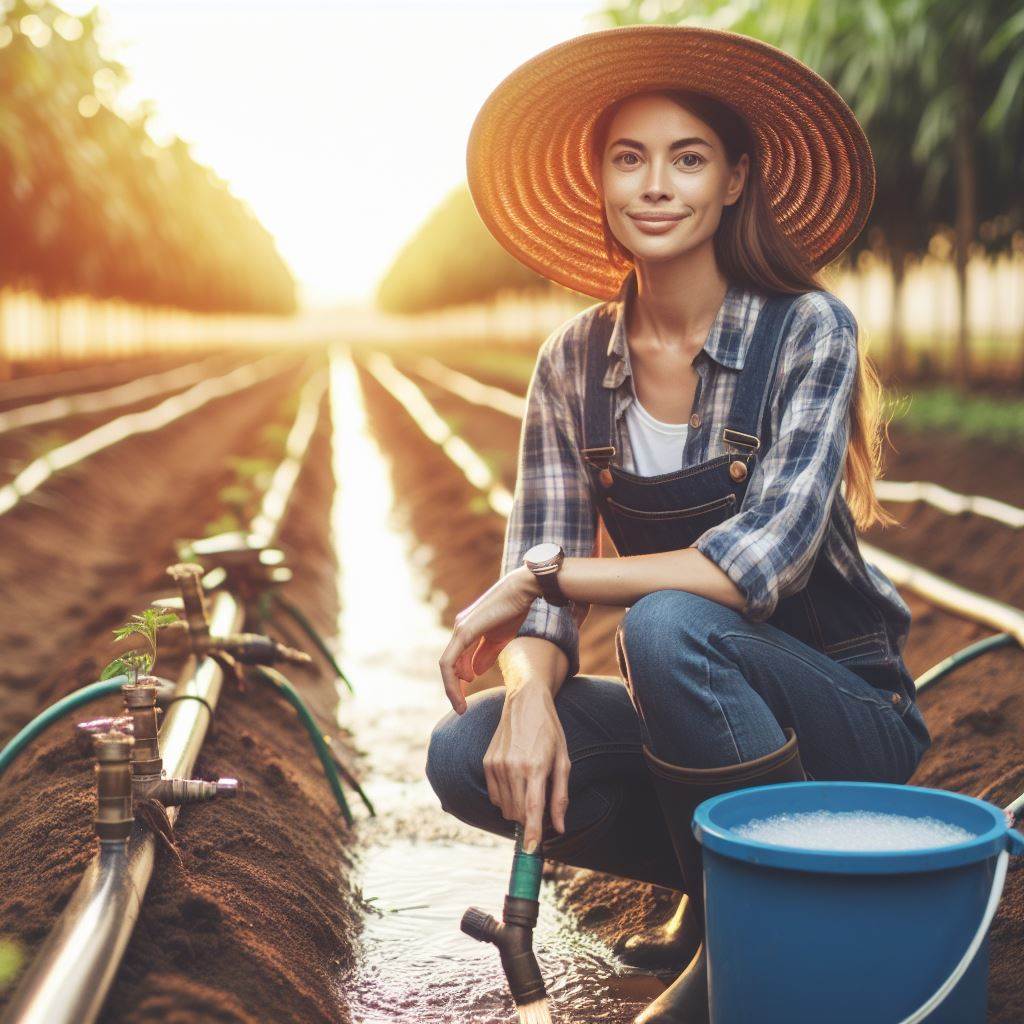Introduction
Let’s Explore Water Conservation Tech: Agri Laws Shift
Water conservation in agriculture is crucial for ensuring sustainable farming practices and mitigating environmental impacts.
With the recent shift in agricultural laws towards promoting water conservation technology, farmers are increasingly adopting innovative solutions to optimize water usage.
One key aspect of this shift is the integration of advanced irrigation techniques such as drip irrigation and precision farming.
These methods enable farmers to deliver water directly to the root zones of crops, minimizing wastage and maximizing efficiency.
Furthermore, the implementation of smart irrigation systems equipped with sensors and automation technology allows for real-time monitoring of soil moisture levels and weather conditions.
This data-driven approach enables farmers to adjust irrigation schedules accordingly, reducing water usage while maintaining optimal growing conditions.
Additionally, the adoption of soil moisture monitoring devices and remote sensing technology enables farmers to precisely manage irrigation, ensuring that crops receive the right amount of water at the right time.
This not only conserves water but also enhances crop yield and quality.
Overall, the shift towards water conservation technology in agriculture represents a positive step towards sustainable farming practices.
By embracing innovative solutions and leveraging technological advancements, farmers can contribute to the efficient use of water resources while ensuring the long-term viability of their operations.
Background on Water Consumption in Agriculture
A. Statistics and facts about water usage in agricultural practices
Overall, the background on water consumption in agriculture reveals the urgent need for improved water management and conservation techniques.
The statistics and facts highlight the significant role of agriculture in freshwater consumption and emphasize the inefficiency of traditional irrigation methods.
It is essential to address these issues to ensure sustainable water usage in agriculture.
The agriculture sector must undertake measures to enhance water management practices to mitigate water scarcity and environmental degradation.
Transform Your Agribusiness
Unlock your farm's potential with expert advice tailored to your needs. Get actionable steps that drive real results.
Get StartedPoor water management not only exacerbates water shortages but also leads to economic losses for farmers.
Consequently, implementing efficient water conservation techniques becomes crucial for achieving water security and promoting sustainable development.
B. The need for better water management and conservation techniques
Adopting better water management practices is beneficial for both farmers and the environment.
By optimizing water resources, farmers can increase crop yield and reduce production costs.
Precision farming methods, such as drip irrigation, provide water directly to plant roots, minimizing evaporation and seepage.
This approach significantly reduces water wastage, contributing to overall water conservation efforts.
Furthermore, innovative conservation techniques offer additional advantages beyond water preservation.
Drip irrigation and precision farming also help minimize the use of fertilizers and pesticides.
By supplying water directly to plants, these techniques prevent excessive nutrient leaching and reduce the contamination of water sources.
This leads to improved environmental outcomes, protecting both ecosystems and human health.
Therefore, the background on water consumption in agriculture illustrates the pressing need for improved water management and conservation techniques.
Agriculture’s substantial water usage and the inefficiency of traditional irrigation methods necessitate immediate action.
Through the adoption of innovative techniques like drip irrigation and precision farming, farmers can maximize water resources, boost crop yield, and protect the environment.
It is crucial for the agriculture sector to prioritize water conservation to ensure a sustainable future for both farming communities and the planet.
Read: 2024 Farm Bill: Key Changes Explained
Overview of Traditional Water Conservation Practices in Agriculture
Despite the widespread use of traditional water conservation practices in agriculture, there are several limitations and drawbacks associated with these methods.
Farmers have long employed various techniques to conserve water and ensure its efficient use in crop production.
These practices have evolved over time, taking into account the local climate conditions, soil characteristics, and crop types.
A. Conventional methods currently employed by farmers
Surface irrigation is one of the oldest and most common methods used by farmers.
It involves flooding or furrow irrigation, where water is distributed over the fields.
However, this technique often results in significant water loss due to evaporation and runoff, leading to inefficient water use.
Sprinkler irrigation is another widely used method that involves spraying water over the crops through mechanical devices.
While it allows for better control of water distribution, there can be issues of over-watering and uneven application, leading to water wastage and potential crop damage.
Drip irrigation has gained popularity in recent years due to its ability to deliver water directly to the roots of plants, minimizing water loss.
Showcase Your Farming Business
Publish your professional farming services profile on our blog for a one-time fee of $200 and reach a dedicated audience of farmers and agribusiness owners.
Publish Your ProfileHowever, this method requires regular maintenance, including checking for clogged emitters and repairing leaks.
Additionally, the installation costs can be high, making it less accessible for small-scale farmers.
Rainwater harvesting is a practice that involves collecting and storing rainwater for later use in irrigation.
It relies on the availability of rainfall and the capacity of storage systems.
While it can be an effective way to conserve water, it may not be feasible in areas with limited precipitation or inadequate storage infrastructure.
Tillage practices, such as conservation tillage, aim to reduce water runoff and soil erosion.
However, these techniques can lead to soil compaction, which impedes water infiltration and affects plant growth.
Balancing the benefits of conservation tillage with the potential drawbacks is essential for sustainable water management.
Rotational grazing is an approach that involves controlled grazing of livestock to ensure proper water distribution and vegetation growth.
When done correctly, it can contribute to efficient water use and improved pasture quality.
However, improper rotational grazing can lead to overgrazing in certain areas, negatively impacting water conservation and ecosystem health.
B. Limitations and drawbacks of traditional techniques
Despite the limitations and drawbacks of traditional techniques, it is important to acknowledge that they have played a significant role in water conservation in agriculture.
They have served as the foundation for the development of more advanced technologies and practices aimed at enhancing water efficiency and sustainability in farming.
As we move forward, it is crucial to continue exploring innovative water conservation technologies and supporting farmers in adopting sustainable irrigation practices.
Combining traditional knowledge with modern solutions can pave the way for a more water-conscious agriculture sector that ensures food security while preserving our precious water resources.
Read: Blockchain for Traceability: Policy Effects
Advancements in Water Conservation Technology
A. Introduction to new innovations and tools available in the market
- The development of new technologies has revolutionized water conservation efforts.
- These innovations provide efficient and effective solutions for managing water resources.
- Farmers and agricultural professionals now have access to a range of tools and techniques.
- These advancements aim to optimize water usage in agriculture and minimize waste.
- Water conservation technology plays a crucial role in sustainability and environmental stewardship.
B. Examples of cutting-edge technologies related to water conservation in agriculture
- Drip irrigation systems: These systems deliver water directly to the plant roots, reducing evaporation and waste.
- Smart irrigation controllers: These devices use weather data and soil moisture sensors to adjust watering schedules.
- Variable rate irrigation: This technology adjusts water application rates based on soil type and crop requirements.
- Water-efficient sprinklers: These sprinklers are designed to minimize water loss through wind drift and evaporation.
- Soil moisture monitoring: Sensors provide real-time data on soil moisture levels, helping farmers optimize watering.
- Precision agriculture: High-tech tools enable farmers to monitor plant health and water needs on a per-field basis.
- Rainwater harvesting systems: These systems collect rainwater for later use in irrigation, reducing reliance on freshwater sources.
- Aquaponics: This sustainable farming method combines aquaculture and hydroponics to maximize water efficiency.
- Water recycling systems: Technologies exist to treat and reuse wastewater for agricultural purposes.
- Aerial imagery and remote sensing: Drones and satellite data help identify areas of overwatering or water stress.
These technologies not only optimize water usage but also offer numerous benefits to farmers:
- Increased crop yields through improved watering precision and efficiency.
- Reduced water costs and expenses associated with water usage.
- Minimized soil erosion and nutrient leaching.
- Enhanced plant and soil health, leading to better crop quality.
- Protection of water sources and ecosystems by reducing runoff and groundwater contamination.
- Improved overall farm sustainability and resilience to droughts and water scarcity.
Most importantly, advancements in water conservation technology have transformed the agricultural industry.
These innovative tools and techniques contribute to efficient water management, addressing the challenges of water scarcity.
By adopting these cutting-edge technologies, farmers can achieve sustainable and environmentally-friendly agricultural practices.
Read: Agri Sensors & Data: Policy Frameworks

Impacts and Benefits of Using Advanced Water Conservation Tech
A. Potential Positive Outcomes in Terms of Water Usage Reduction
- Advanced water conservation technologies reduce water wastage and promote efficient water management.
- Implementation of these technologies can lead to significant reductions in water consumption in agriculture.
- Farmers can optimize water resources and minimize water usage through advanced irrigation systems.
- Efficient water usage ensures sustainable water supply for future generations and reduces the strain on water sources.
- By conserving water, communities can mitigate the risk of water scarcity, especially in drought-prone areas.
B. Benefits to the Environment, Economy, and Society
- Advanced water conservation tech contributes to environmental preservation by conserving water resources.
- Reduced water usage helps protect natural ecosystems, rivers, and lakes from depletion and pollution.
- Conservation efforts lead to the preservation of aquatic habitats and biodiversity in fragile ecosystems.
- Implementing these technologies can create new job opportunities and boost the economy in the water management sector.
- Water conservation enhances community well-being by ensuring access to clean water for domestic use.
- Sustainable water practices promote social equity by ensuring water availability for all members of society.
C. Improved Crop Yield, Enhanced Sustainability, and Reduced Costs for Farmers
- Advanced water conservation tech enables farmers to apply water more precisely, resulting in improved crop yields.
- Optimized water usage ensures that crops receive the required amount of water without over or under watering.
- This technology facilitates better nutrient management, leading to healthier crops and improved agricultural productivity.
- Water-efficient irrigation systems reduce energy costs for farmers and improve the overall sustainability of farming practices.
- By reducing water wastage, farmers can effectively manage their production costs and increase profitability.
- Adoption of water conservation tech can reduce dependence on unsustainable water sources, such as groundwater.
In essence, the impacts and benefits of using advanced water conservation tech are significant and wide-reaching.
Through these technologies, we can achieve substantial water usage reduction, leading to more sustainable water management practices.
This brings positive outcomes for the environment, economy, and society by preserving natural ecosystems, creating new jobs, and ensuring equitable access to clean water.
Furthermore, the implementation of these technologies enhances crop yield, promotes sustainability, and reduces costs for farmers, making agriculture more efficient and profitable.
By embracing advanced water conservation tech, we can pave the way for a more sustainable and water-secure future for generations to come.
Read: Smart Greenhouses: US Policy Dynamics
Review of Recent Agricultural Laws and Regulations
A. The changing legal landscape related to water conservation in agriculture
- Over the past decade, there has been a shift in regulatory frameworks for water management in agriculture.
- Old laws that focused primarily on water rights and allocations are being complemented or replaced with regulations that promote water conservation.
- The changing legal landscape emphasizes the need for farmers to adopt advanced technologies and practices to conserve water.
- Regulations now require farmers to monitor and report their water usage, promoting transparency and accountability in agricultural water management.
- Water conservation plans are now mandatory for farmers, detailing strategies to decrease water usage and increase efficiency.
- These changes in laws and regulations support the broader goal of achieving sustainable agricultural practices that conserve water resources.
B. Governmental initiatives and policies supporting the adoption of advanced tech
- Governments worldwide are incentivizing farmers to adopt advanced water conservation technologies and practices.
- Subsidies and grants are offered to farmers to offset the costs associated with the adoption of advanced technology.
- Governmental initiatives aim to educate farmers about the benefits of advanced tech in water conservation.
- These policies include training programs and workshops to promote the understanding and adoption of advanced water conservation methods.
- The government supports research and development in the field of water conservation technology, fostering innovation and progress.
- By promoting advanced tech adoption, governments hope to achieve significant reductions in water usage and ensure its sustainable availability for future generations.
In fact, the legal landscape concerning water conservation in agriculture has evolved to prioritize efficient water usage.
The changing laws and regulations emphasize the adoption of advanced technologies and practices.
Farmers are now required to monitor and report their water usage, and water conservation plans have become mandatory.
Additionally, governmental initiatives and policies support farmers in adopting advanced water conservation technologies through subsidies, education, and research support.
These efforts collectively aim to ensure the sustainable availability of water resources for both present and future agricultural needs.
Challenges and Barriers for Implementing New Water Conservation Tech
A. Barriers Faced by Farmers in Adopting New Technologies
Implementing new water conservation technologies in agriculture faces various challenges and barriers.
Farmers often encounter obstacles that hinder their willingness to adopt innovative solutions.
Limited financial resources and inadequate technical skills can prevent farmers from accessing and implementing new tech.
Additionally, resistance to change, lack of trust, and difficulties in finding reliable suppliers contribute to the barriers faced by farmers.
B. Economic Considerations and Accessibility Issues
Economic considerations and accessibility issues also pose significant challenges for the implementation of new water conservation technologies in agriculture.
The high cost of new tech can be a deterrent, especially for farmers with limited financial capabilities.
Moreover, the return on investment may take time, discouraging farmers from adopting these technologies.
In regions with inadequate infrastructure, accessibility to new tech becomes a barrier, restricting its adoption among farmers.
Showcase Your Farming Business
Publish your professional farming services profile on our blog for a one-time fee of $200 and reach a dedicated audience of farmers and agribusiness owners.
Publish Your ProfileAdditionally, the unequal distribution of resources and limited availability of financial incentives further complicate the implementation process.
C. Resistance to Change and Lack of Awareness
Resistance to change and lack of awareness are substantial barriers that hinder the adoption of new water conservation tech.
Traditional farming practices rooted in familiarity can impede farmers from embracing innovation.
Furthermore, limited awareness about the benefits and potential of new technologies can hinder their adoption.
Insufficient education and training programs deprive farmers of the necessary knowledge and skills required to utilize new tech effectively.
Uncertainty about the long-term effectiveness and viability of new technologies can also diminish farmers’ enthusiasm for adoption.
Moreover, the absence of communication and knowledge-sharing platforms limits farmers’ access to information, hindering their understanding and utilization of new water conservation tech.
To overcome these challenges and barriers, various strategies can be implemented.
Government support in the form of financial incentives and subsidies can make new technologies more affordable for farmers.
Educational programs and training initiatives can enhance farmers’ understanding and technical skills.
Collaboration between farmers, researchers, and tech providers can foster trust, addressing skepticism and encouraging adoption.
Improving infrastructure and ensuring equal distribution of resources can enhance accessibility to new tech.
Additionally, creating platforms for communication and knowledge-sharing can disseminate vital information about new water conservation tech.
In review, the challenges and barriers faced in implementing new water conservation technologies in agriculture are multifaceted.
Overcoming financial constraints, improving access and affordability, addressing resistance to change and lack of awareness are crucial for successful technology adoption.
By addressing these barriers and implementing supportive strategies, the agricultural sector can harness the benefits of new water conservation tech, mitigating water scarcity challenges and promoting sustainable farming practices.
Success Stories and Case Studies
A. Real-life examples of farmers who have successfully adopted water conservation tech
The case of John Smith highlights the effectiveness of drip irrigation systems.
By delivering water directly to the roots, this technology minimizes water loss and reduces the amount of water needed for irrigation.
Smith’s experience demonstrates that implementing drip irrigation can result in substantial water savings and increased profitability.
Sarah Johnson’s case study demonstrates the power of using soil moisture sensors in irrigation management.
These sensors provide real-time data about soil moisture levels, allowing farmers to optimize irrigation schedules and only water when necessary.
Johnson’s success story showcases how this technology can improve crop yields while conserving water resources.
William Davis chose to tackle water conservation through rainwater harvesting.
His farm’s infrastructure included systems to capture, store, and distribute rainwater for irrigation purposes.
By collecting and utilizing rainwater, Davis reduced his dependence on groundwater while ensuring a sustainable water source, especially during periods of drought.
B. Highlighting the positive outcomes and achievements in their operations
These success stories indicate that adopting water conservation tech can lead to positive outcomes and achievements in agricultural operations.
They demonstrate that implementing these technologies can result in cost savings, increased profitability, improved crop yields, and reduced environmental impact.
In short, the success stories and case studies presented here emphasize the benefits of water conservation tech in farming.
By showcasing real-life examples of farmers who have effectively utilized these technologies, it becomes evident that investing in water conservation can lead to significant positive outcomes and achievements.
These success stories serve as inspiration for other farmers to adopt similar water-saving techniques and contribute to a more sustainable and efficient agricultural sector.
Recommendations and Best Practices for Farmers
A. Suggestions for farmers to transition to water conservation technologies
- Conduct a water audit to identify areas of improvement and prioritize water-saving measures.
- Educate yourself on different water conservation technologies available in the market.
- Seek guidance from agricultural experts or water conservation organizations for tailored advice.
- Start with simple and low-cost technologies, such as drip irrigation or rainwater harvesting.
- Monitor and control irrigation schedules to avoid overwatering and wastage.
- Implement precision agriculture techniques to ensure efficient water use based on crop needs.
- Utilize soil moisture sensors to accurately determine irrigation requirements.
- Explore the use of recycled or treated wastewater for non-potable purposes, such as irrigation.
- Consider investing in smart irrigation systems that use weather data and sensor feedback for optimal water application.
- Develop a long-term water management plan that includes regular maintenance and upgrades of existing technologies.
B. Guidance on selecting appropriate tech and overcoming implementation challenges
- Assess your farm’s specific needs and conditions before selecting any water conservation technology.
- Consider factors such as soil type, climate, crop type, and water availability in the decision-making process.
- Seek advice from experts who can help match your requirements with the most suitable technology.
- Research the performance and reliability of different technologies and consider their long-term costs and benefits.
- Test selected technologies on a smaller scale before implementing them across the entire farm.
- Prepare a detailed implementation plan that includes timelines, budgets, and resource allocation.
- Train farm workers on the proper use and maintenance of water conservation technologies.
- Address any logistical or infrastructure challenges that may arise during implementation.
- Identify potential funding sources, grants, or subsidies that may support the adoption of water conservation technologies.
- Maintain open communication with other farmers and participate in collective efforts to share knowledge and resources.
By following these recommendations and best practices, farmers can successfully transition to water conservation technologies and contribute to the sustainable management of water resources in agriculture.
Implementing these measures not only reduces the strain on water supplies but also improves farm productivity and resilience in the face of water scarcity challenges.
Let us work together to create a more water-efficient agricultural sector and ensure a secure and sustainable future for generations to come.
Conclusion
A. Key points discussed in the blog post
- Water conservation technology plays a crucial role in addressing the challenges of agriculture.
- Advanced irrigation systems like drip irrigation, precision sprinklers, and soil moisture sensors help optimize water usage.
- Smart farming technologies such as IoT-based monitoring and data analytics enable farmers to make informed decisions.
- Implementing regulations and incentives can encourage farmers to adopt water-saving practices.
- Collaboration between farmers, researchers, and policymakers is vital for the success of water conservation efforts.
B. Closing thoughts on the future of water conservation technology in agriculture
The future looks promising as the development and adoption of innovative water conservation technologies continue to grow.
With increasing awareness of the importance of resource efficiency and sustainability, more farmers are likely to embrace these technologies.
Ongoing research and technological advancements will further enhance the efficiency of these systems, making them more accessible and cost-effective.
To successfully tackle the water scarcity challenges, a multi-faceted approach that combines policy support, technological innovation, and education is essential.
By working together, we can create a more water-efficient and sustainable agricultural industry.




